As Gueuzerie Tilquin approaches its tenth anniversary this March, there can be no question that the esteemed lambic blendery has seen great success in its first decade. I paid a visit to Founder/Owner/Master Blender Pierre Tilquin in late August 2018, to catch up on how things are going, and to discuss the new beers that have been created recently, as well as future plans. Lambic aficionado Patrick Van der Spiegel of Halle joined me and Pierre for the tour and tasting. Van der Spiegel created the Facebook and Instagram pages, “The Land of Geuze.” The Facebook page is linked here and and the Instagram page is here.
Gueuzerie Tilquin, located in Rebecq in the Province of Wallonian Brabant, first filled barrels with wort on March 12, 2009. That first wort was from Brouwerij Boon, and the next day, Tilquin took delivery of a batch of wort from Brasserie Cantillon. Then, on March 18, 2009, the first batch of wort from Brouwerij Lindemans arrived. Tilquin was the first new lambic blendery to open since Geuzestekerij De Cam opened in Gooik, in the Province of Flemish Brabant, in 1996. My first visit to Tilquin was in late May, 2010.
Lambic blenderies purchase wort, or unfermented beer, directly from lambic breweries during the winter brewing season, and then add this wort immediately to their own barrels for aging, to produce what will in time become lambic. Lambic of different ages, primarily 1, 2, and 3 year old, can be blended together to make Oude Gueuze, or lambics of different ages can be blended with fruit to produce fruit lambics.
“As you know, we started with 222 barrels in the 400-liter size (about 3.4 U.S. barrels each) in 2009. Now, we have 575 barrels of 400-liters,” says Pierre Tilquin, as I toured the blendery again, for the seventh or eighth time since it opened.
Tilquin continued: “With the 575 barrels I have here now, I have a stock of about 2,300 hectoliters (1,960 U.S. barrels) of lambic. So I can produce about 1,350 hl of beer per year. This is a significant increase from the past. For the 2016-2017 lambic brewing season, I produced about 1,030 hl of lambic to sell, including both bottles and draft; for the 2017-2018 season, it was 1,350 hl.” He added: “I think this building is maxed out as far as barrel capacity. I probably would need to expand the building or rent space nearby to add more capacity.”

Why 400-liter barrels? Tilquin remarked: “Having completed internships at two of the great lambic breweries, Brasserie Cantillon and Brouwerij 3 Fonteinen, for six months each, I was convinced that smaller barrels will produce a more complex, richer lambic beer than using larger barrels. Also, I purchased the first 222 barrels, which were former wine barrels, for a good price: some cost 60 euros each, and some, 70 euros. Now, as I have been using 400-liter size barrels for almost ten years, I am convinced I was correct.”
Gueuzerie Tilquin now uses wort from breweries Boon, Cantillon, Girardin, and Lindemans in its blends. Tilquin, in fact, is the only other lambic maker that Brasserie Cantillon will sell wort to, and it’s just a couple of brews per year: “I receive two brews of 62 hectoliters each season from Cantillon, so that is 124 hl (about 105.6 U.S. barrels) in total. I only use Cantillon as a three year lambic in my blends, as it adds a lot of complexity,” Tilquin remarked.

Tilquin added: “In the typical Tilquin gueuze blend (which is comprised of ten 400 liter barrels of lambic) I use four barrels of Lindemans, three barrels of Boon, two barrels of Girardin, and one barrel of Cantillon. I feel these four different lambics each add something unique to the blend, and together, they make for a very accessible, complex, drinkable Oude Gueuze.”

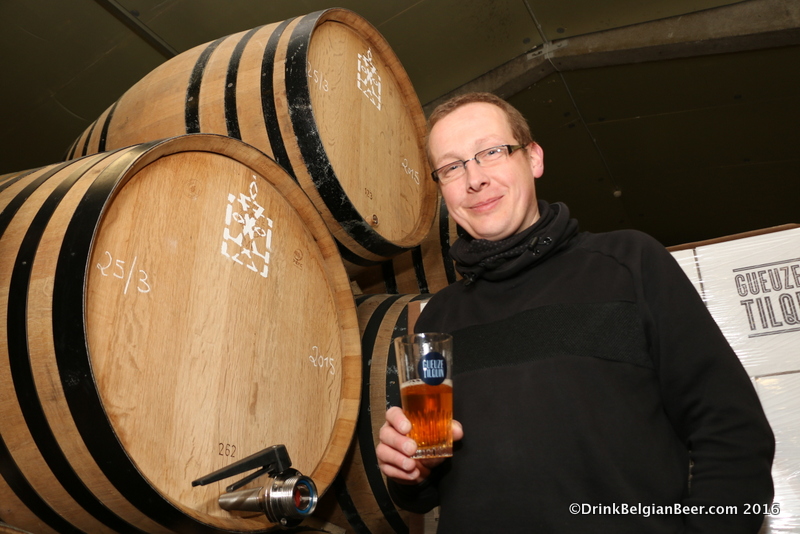
The actual size of the blends is a little less due to the fermentation as well as evaporation in the barrels: “With a 400-liter barrel, we have a yield of an average of 380 liters of lambic, so we blend the contents of 10 barrels together to fill our 38 hectoliter blending tank with 3800 liters of lambic,” (38 hectoliters, about 32.4 U.S. barrels) Tilquin remarked.
Tilquin continued: “We are also working more efficiently now. We dismantled the old warm chamber and added a new Italian built bottling line in 2017, which can fill 2,000 bottles in the 37.5 cl size per hour. That means that we can bottle an entire (38-hectoliter) blending tank in one day now, and it took two days last year with the older bottler. So we can fill 10,000 bottles in the 37.5 cl size, or 5,000 in the 75 cl size, from one tank. We additionally built a new warm chamber that is set for a year round temperature of 20 degrees celsius (68 fahrenheit.) This system can both heat and cool the room.”
Tilquin added: “The reason for having a temperature controlled setting of 20 degrees (celsius) is that it aids in making sure the lambic will re-ferment in the bottle in a reasonable amount of time. If it is too cold, the yeast may work more slowly, and we want to have the bottles that we fill in the winter ready and fully conditioned in May, when we begin to sell beer from the winter season. So having a constant temperature provides a more homogeneous re-fermentation in bottles.”
Tilquin then told me about the new fruit beers he has been creating lately, and the reasons behind it. “I have seen a small but noticeable drop in the demand for the Oude Gueuze Tilquin à L’ancienne, and a continuing increase in the demand for fruit beers, such as Mure (made with blackberries) and Quetsche (made with plums from the Alsace region of France.) Beer drinkers always want something new these days, and I enjoy trying to find and use fruits that other breweries are not using, as well as other interesting things.”

In mid-January 2019, Tilquin took delivery of some new 600-liter barrels, with the aim to replace some of the oldest 400-liter barrels at the blendery. He also acquired some 220-liter barrels. “These smaller barrels will be used only when we don’t have enough wort to fill a full 400-liter barrel when receiving wort, so that we don’t have a half full 400 liter barrel. I also bought some 500-liter barrels, with stainless steel openings on the top of the barrels, to make the fruit experiments larger,” he commented.
Pierre Tilquin has been doing a lot of fruit beer experiments in the last few years. Gueuzerie Tilquin now has a total of 18 stainless steel tanks in the 20 hectoliter size, as well as a main blending tank of 38 hectoliters, and a smaller one of 27.5 hectos. The more tanks you have, the more experiments you can do!
Tilquin remarked in early February 2019: “We now have four employees here at the blendery, and I am still seeking a secretary to handle the administrative duties. So things are progressing, but somewhat slowly, because we are so busy with the putting lambic in barrels, blending, packaging, and all the other things we have to do to run a business.”

Let’s talk first about the two most recent releases in the Tilquin range, dating to September 2018, starting with Groseille Rouge. “This is a lambic made with red currants,” Tilquin says, as he poured glasses of what was a delectable reddish nectar from a 75 cl bottle for me and Patrick, inside the blendery’s cozy new tasting room/bar. Groseille Rouge contains 260 grams of red currants per liter of lambic, and was bottled in both 37.5 and 75 cl corked bottles. Red currants are native to much of Europe, and are a member of the gooseberry family. Oude Groseille Rouge Tilquin à l’Ancienne, like all of the other bottled lambics from Gueuzerie Tilquin, is unfiltered and unpasteurized. 10,000 of the smaller bottles were filled in February 2018, and 5,000 of the larger bottles, in March 2018. Tilquin remarked: “There was an issue with this beer that somehow caused the 37.5 cl bottles to be superior in fruit character and color than those in the 75 cl size. We used one blending tank for the 37.5 cl bottles, and another for the 75 cl bottles. For some reason the fruit extraction was better in the tank used to fill the smaller bottles.”
Tilquin added: “We will taste them both so you will see what I mean,” which was a remark that I heartily agreed with, as did Patrick. I did find the smaller bottles to be a bit fruitier than those in the 75 size, but I would not say it was a huge difference. You see, Pierre Tilquin is a perfectionist, and I mean that in a very good way. He always wants to make sure his beers are top quality, and he is apologetic about even small mistakes, which can easily happen when you are producing beers made with wild yeasts via spontaneous fermentation. After all, creating and blending high quality fruited lambics is no easy task. Tilquin continued: “At 6.6 % abv (alcohol by volume) it is not even as strong our oude gueuze (7% abv.) It’s a very fruity, drinkable beer. This, along with the Pinot Gris, will be released for sale on the first of September (2018) so Groseille Rouge will have had a refermentation time in the bottle of about six months.”
Groseille Rouge will not return for 2019. “We will create a new black currant lambic for 2019,” Tilquin remarked, without saying if beer lovers might see another red currant lambic from the gueuzerie again in the future. “We will also debut a lambic with wild blueberries,” he added. I should note that, with a stock of only about 2,300 hectoliters of lambic to work with per year, Pierre Tilquin can only make so many different beers for public release. “I am pleased with how the Groseille Rouge turned out, but in order to make some new fruited beers to release to the public, we have to make some choices on what to continue with. We simply don’t have enough lambic to do everything we would like.”
As of early February 2019, neither the new black currant or the new wild blueberry lambics have been bottled yet. “These fermentations take time, but we hope that both will be ready for release in September,” Tilquin says.

Now, back to Pinot Gris, which was the second new fruited lambic that Gueuzerie Tilquin released for sale last year. Tilquin says: “Oude Pinot Gris Tilquin à L’Ancienne is made with Pinot Gris (white) wine grapes.This was the first time that Pinot Gris wine grapes were used for making a lambic beer.” Pinot Gris is a strong, but refined, fruited lambic, which contains 280 grams of Pinot Gris grapes per liter of lambic, and 8.4% alcohol. “This is a beer that was taking a long time to mature. It had a refermentation time in bottles of over 8 months before the September 1 release date,” Tilquin added. “I find that it is complex, refreshing and flavorful, with a very noticeable aroma of the white wine grapes. It is very dry, and you don’t really perceive the higher alcohol in it. This one will return for 2019.”
That’s good news!

Oude Pinot Noir Tilquin à L’ancienne debuted as the tenth anniversary beer of the great Brussels beer cafe, Moeder Lambic Fontainas, in 2016. Tilquin remarked: “I found organically grown Pinot Noir grapes from a wine maker in the Alsace region of France, Domaine Valentin-Zusslin, a few years ago. The Pinot Noir grapes are of a reddish color, and the Moeder Lambic anniversary blend was a big success. But I had to change grape producers after that first batch, as I could not source them any longer from the same wine maker. So I found another grape producer in the Alsace for batch 2 and 3. Now, I use 260 grams of Pinot Noir grapes per liter of lambic in this, batch 3. The alcohol is 8.2% abv, and it is a very refined, characterful, fruity beer. Also, for the 2017-2018 bottling season, we added a small amount of sugar to all of our fruit beers to insure a proper re-fermentation in the bottle. We did have some issues with undercarbonated bottles from the 2016-2017 season.”
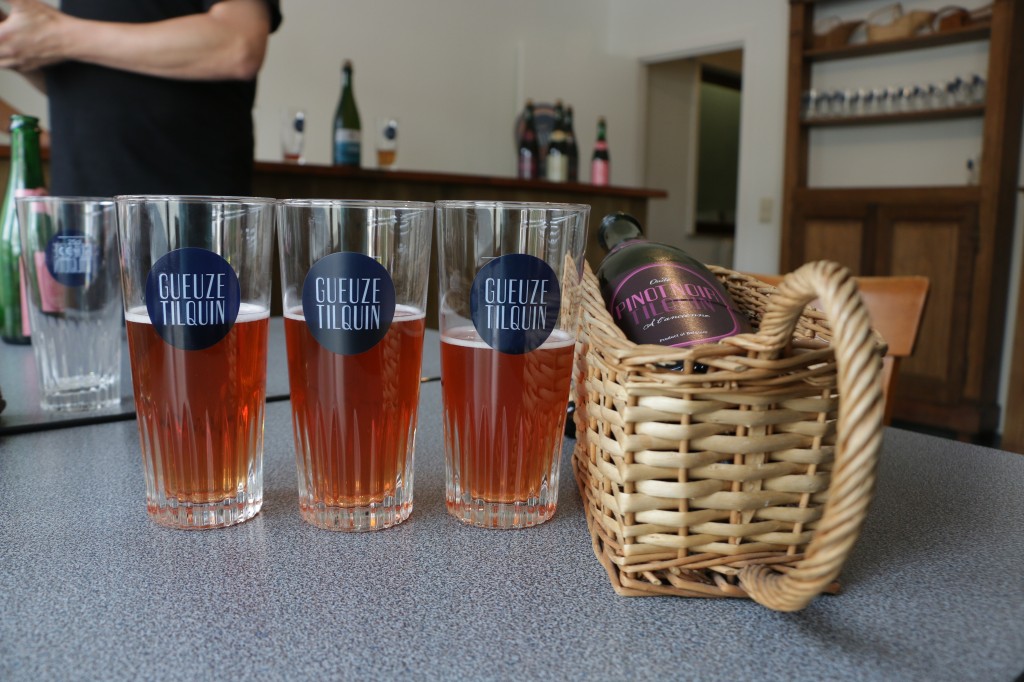
As you can see from the videos, there are no carbonation issues with the 2017-2018 season beers! I enjoyed a bottle of the batch 1, Moeder Lambic anniversary Pinot Noir in 2017, and thought it was a fantastic, complex, fruity lambic. I found the 2018 version, bottled on January 4, 2018, to be just as good. Note that the recipe has changed a bit since batch 1, namely, that batch used 350 grams per liter of grapes and had an alcohol content of 7.7%. Batch 3 has a slightly higher alcohol content, and contains less fruit per liter. No matter, both are excellent beers, well worth seeking out.
In 2018, pallets of Groseille Rouge, Pinot Gris, and Pinot Noir were shipped to countries such as Canada, the USA, Japan, Italy, Norway, Sweden, and more, so the new beers could be released on the same day, September 1. Tilquin also held a release at the blendery the same day, with limits of one bottle each per person of Pinot Gris, and the 75 size of Groseille Rouge, as total production was only 5,000 bottles of each. For Pinot Noir and the small bottles of Groseille Rouge, the limit was two per person. I was at 3 Fonteinen’s Open Door days that Saturday, and I heard that a big crowd was on hand to buy bottles at Tilquin. Given the difficulty in finding these three beers, my suggestion to lambic lovers out there is: buy them when you see them!
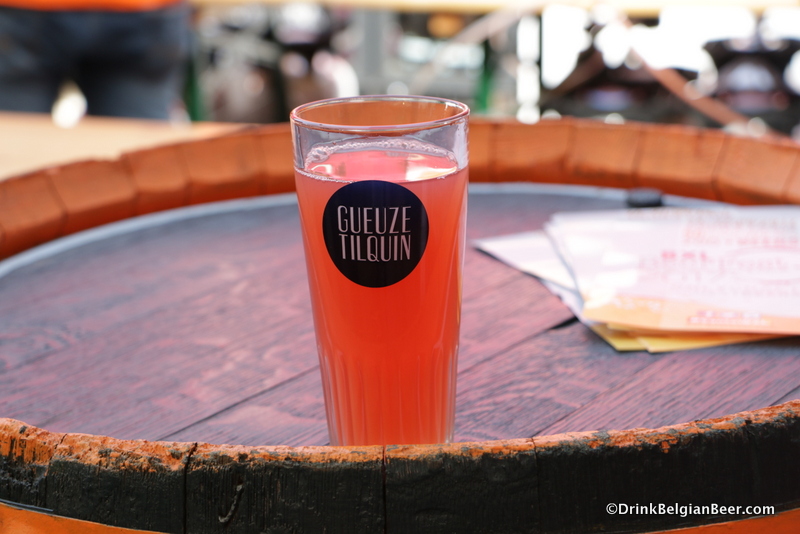


Important: to you Mure and Quetsche drinkers out there, don’t panic! These brews are now a permanent part of the Gueuzerie Tilquin range. They aren’t going anywhere. Also, sadly, I do have a little bad, short term news: for the second year in a row, for the 2018-2019 season, there will once again not be a Prunes de Namur version of the Quetsche. The reason is the weather: during the spring of 2017, the flowers from these trees were frozen during an early spring freeze. Then, the summer of 2018 was very hot and dry in Belgium, and there was not enough rainfall to encourage the growth of these Belgian plums, so most simply fell off the trees. So the plums for the Quetsche will continue to come from the Alsace in France until a good harvest occurs in Belgium. “It’s a pity, as I prefer the Prunes de Namur plums over the ones from Alsace,” Tilquin commented.


After tasting three fruit lambics in a row, Tilquin suggested that we try something different. “I have a beer here, Saison Vignon, which is an experimental collaboration with one of the brewers of Brasserie de la Senne, Max. His own project, on the side, is called ‘Funky Max.’ This saison has a small amount of one year old Tilquin lambic blended in, 2.5% of the volume, and it was aged in barrels here for three or four months. It uses only one hop, Hallertau Blanc. It is a very dry, refreshing brew, with a hint of acidity.” I liked this easy drinking, hoppy, lightly funked brew, and I felt it could use even more lambic in future blends. Tilquin agreed: “Max is using a fairly fast acting brettanomyces yeast for re-fermentatin in the bottle, so the small amount of lambic we blended in is not enough. We intend to increase the volume of lambic used in the beer to as high as 10%, so it will have a more pronounced lambic character, while still retaining its hoppiness, and aroma of the hops. This is intended to be a great summer beer, for things like a barbecue or other events.” He added: “We still have to decide whether Saison Vignon will be a regular beer in the Tilquin range, or whether it will be something only made for Max.”

“It’s a really nice one, so easy to drink, and yet it doesn’t taste to its 6.5% abv,” Van der Spiegel remarked.
I have no problem in confessing that I love dry, funky saisons, almost as much as lambics. I hope Saison Vignon becomes a readily available brew in the future, especially once newer batches with a higher lambic content are rolled out. Bring it on.


Other experimental beers
Pierre Tilquin and his Gueuzerie Tilquin have been doing a lot of experiments with fruit beers for a couple of years now, and beer lovers lucky enough to have attended a few public tastings and certain beer festivals will have had a chance to taste these some of these various lambics. Tilquin commented: “In 2017, I debuted Experimental Fruit Series #1. In 2018, Experimental Fruit Series #2 debuted this past weekend at the BXL Beer Fest in Brussels. The experimental beers included Cassis, as well as a different version of Groseille Rouge, and some others.”
I attended the BXL Beer Fest in 2018, and can attest to the great variety of beers on offer there from Tilquin and other breweries. 300 different beers from 60 breweries across the globe, to be exact, were on offer. See here for an article about the event.
Speaking of experiments, the next bottle that Tilquin opened for us to taste was a 75 cl bottle of “Rhubarbe Rouge” from Experimental Fruit Series #1. “When we first bottled this beer in July 2017, it had way too much sulphur aroma and taste from the rhubarb,” Tilquin remarked. “So I am interested to taste it again now. I think it will have improved, as the sulphur taste and aroma will normally lessen with time.” That is exactly what happened. After nearly 14 months in the bottle, the beer had a mild acidity and noticeable fruit character from the rhubarb, and no sulphur. I really enjoyed this rhubarb lambic. For you lambic drinkers out there, you should be aware the Brasserie Cantillon’s Nath is also a lambic made with rhubarb. These beers can be very, very good when you really know how to make them (which Tilquin and Cantillon both do.)
The last beer that the three of us tasted that day was an experimental gueuze made with organically grown and made maple syrup. “This is a bit of a crazy beer,” Tilquin began, as he prepared to open the bottle. “This one started as a normal gueuze in a blending tank, a blend of 1, 2, and 3 year old lambics, with 7% abv. We then added maple syrup to the blend, and it fermented to 9.5% abv during the secondary fermentation. We added a small amount of maple syrup at bottling, and it re-fermented to 10% alcohol. Let’s say it’s a winter gueuze.” I found this brew to be absolutely delicious: a strong gueuze, with a lot of body, but not heavy at all. While I could tell there was something going on with the beer due to its unique flavor, I may not have been able to pick out that it was maple syrup that was used in the blend if I had not been told. Tilquin added: “This beer was bottld two years ago, so probably the brettanomyces yeasts have eaten all of those sugars from the maple syrup. If it was younger the maple syrup character might be more.”
No matter how it happened, the maple syrup gueuze was one of the best strong lambics I have ever tasted. I would have judged its alcohol level as about 7% abv if I was tasting it blind. The brew had an incredibly rich mouthfeel, yet without having a heavy body. Acidity was light, with a moderate funkiness. In short, it was a truly stellar beer. Tilquin remarked: “Batch 2 is in the tanks now, and it is fermenting slowly. We will wait until it gets to 0 degrees plato before we do anything else with it. Also, our aim is actually to have batch 2 be just a little less alcohol than batch one: we started with a gueuze blend again, at 7% abv, and hope to get the secondary fermentation to get the beer to 9% alcohol, and to once again add maple syrup during bottling to spark a re-fermentation. Our goal is to have the beer finish at around 9.3% abv.”

A small experimental lambic brewery
As we walked through the blendery, Tilquin pointed out a small, 400-liter brewhouse that he purchased from a brewery in France. “I would like to start a small lambic brewery here sometime in the next couple of years. It will be just an experiment, and a separate project from the blendery. I would add a small coolship outside as well, and do the entire process here. I might have to increase the size of the building a bit to do so. This would be a long term project over say, 3, 4, 5 years. I want to slowly start to brew and gain confidence in my brewing abilities, and elaborate from there. If I could brew about 12 times a year, I could build up a little stock of 100% Tilquin lambic. Each brew would only fill one of the 400-liter barrels here, so this is just something I’d like to do to create something new. Note that I do not want or plan to change the blends we make here, from the four lambic breweries. These blends work so well that I would never want to do that. I’m very lucky to be able to use four different lambics, as each one gives something to the taste, making for very rich blends.” Tilquin did not have time to install the brewery for the 2018-2019 season, so this is something that will have to wait at least one more season.
You might ask: who helps Pierre Tilquin taste all of those experimental beers? After all, it would be quite a few beers to taste on a regular basis, even for he and his four colleagues. Also, to get an objective opinion, sometimes its good to seek comments from outside the confines of your own brewery. Luckily, Pierre Tilquin has a group of friends that he has known for a number of years, known as the Tilquin Enthusiasts. These friends volunteer their time to help out when some extra manpower is needed, and have the added benefit of being in the inner circle that gets to taste Tilquin’s experimental beers. One of the better known members is a big fan of lambics, especially those of Gueuzerie Tilquin, Kevin Desmet. Kevin is a co-founder of the aforementioned BXL Beer festival, and also an admin on the Tilquin Enthusiasts page on Facebook.
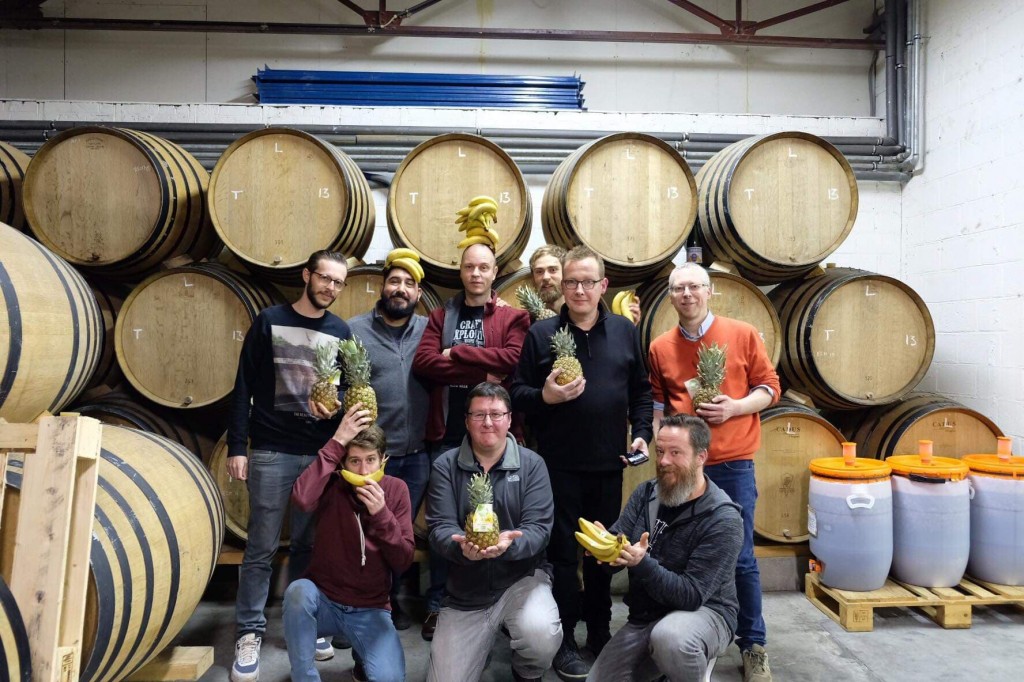
I asked Kevin what is the best part of being closely associated with such a superb lambic maker, and he replied: “The Tilquin Enthusiasts group initially started as a semi-serious joke, created by Rich Soriano, four years ago on Facebook, that has since grown to be a fun discussion and sharing group focused around Gueuzerie Tilquin. Back then, there was only a Cantillon enthusiasts page, but we thought Tilquin deserved an equal amount of praise. We’ve built up a group of +2,500 members who actively share tasting notes or info about the Gueuzerie. We were already fans of Gueuzerie Tilquin and friends with Pierre before but the group brought us even closer together, and allowed us a big glimpse behind the scenes at the blendery. The admins have become good friends of each other and we often talk about the Gueuzerie and its splendid lambic beers, we even get to choose some of the ingredients Pierre uses for his blends. At least once a year the admins of the Enthusiasts group get together to share beers at the blendery and make a special lambic blend, a blend that is often just a crazy idea that popped into of our heads. The first blend we made like that has become a real sought after gem: Tilquinananas, a banana and pineapple lambic blend. Since then, we’ve made many more crazy blends, and it’s good fun each time we make these. I can say that the newest blend is going to be an alternative version of the Tilquinananas, a vamped up version that will amaze many fans. As a group we’re heading towards our fifth year of existence, but we’re still as excited as when we started with it.”

I asked another friend, Rich Soriano, an American who is very passionate about lambic beers, who has lived in Belgium for a number of years, for his take on being the founding member of Tilquin Enthusiasts. He replied: “I first met Pierre in 2014. Tilquin gueuze by this time was one of my top beers, and he just so happened to be open Saturday mornings. I started going there pretty regularly. Another Tilquin Enthusiast admin, Seb, would usually be there, and we’d stand in the middle of the the then tiny, very cold blendery, drinking random beers and yelling terrible beer ideas at Pierre (who would of course shoot them down…they really were bad ideas!).
With the creation of the Tilquin Enthusiasts group, I picked a few people who’s opinions I respected to help administer it. It ended up being a great choice of personalities, as our friendship has really grown, well past just lambic and a Facebook group. We hang out, and there’s an active group chat, and we all help each other out when we can. It’s definitely been a rewarding experience. I’m at pretty much every event at the blendery, giving tours or just being a distraction in general.”


Gueuzerie Tilquin will of course be open for Toer de Geuze on May 4-5, 2019. Tilquin told me just before this article was published: “During Toer de Geuze, the new batches of the following beers will be released : Gueuze Tilquin à l’ancienne, Quetsche Tilquin à l’ancienne, Mûre Tilquin à l’ancienne, Gueuze Tilquin – Draft Version, Quetsche Tilquin – Draft Version and Mûre Tilquin – Draft Version. As usual, there will be a free glass of lambic for each visitor making the guided tour. Most probably, I will also serve some experimental fruit beers on draft.”
He added: “If I have time to make the label and the carton box, I will release on the occasion of Toer de Geuze, a magnum of Gueuze Tilquin à l’ancienne (1,5L), aged 1 year in the bottle. Sold at one bottle per person.”
Sounds fabulous!
For anyone visiting France the last weekend of April, the 27th and 28th, Gueuzerie Tilquin will be present at the Lyon Bière Festival. Due to that event, Tilquin will not be present at the Zythos Beer Festival in Leuven this year.
For anyone wishing to experience a great beer tour that will visit most of Belgium’s lambic breweries and blenderies, Belgian Beer Me! Beer Tours still has a few seats left on the “Wild and Spontaneous Beer Tour of Belgium” which will run from April 29-May 6, 2019. The group will be visiting Gueuzerie Tilquin for a special tour during that week. See here for full details about the “Wild and Spontaneous Beer Tour of Belgium.“
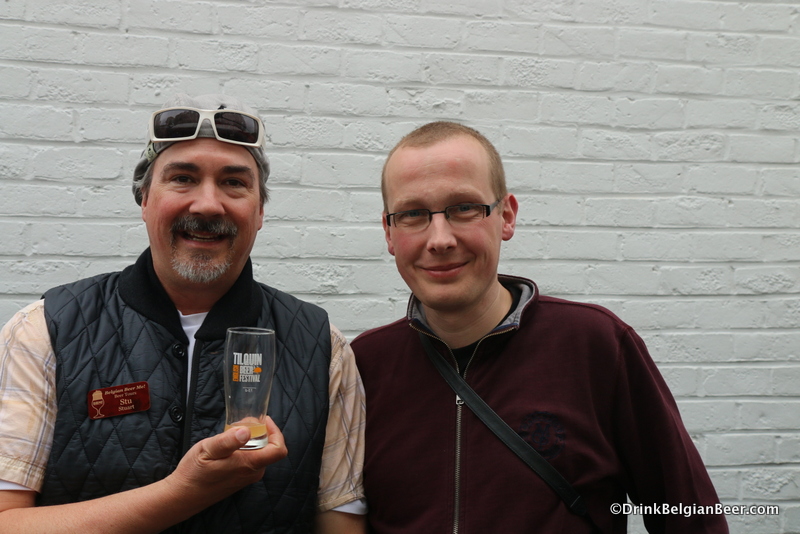
If you like this website, please like our Facebook page here
and our Twitter page here


Leave a Reply